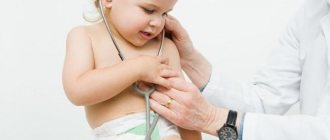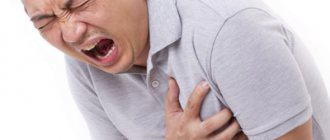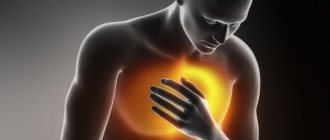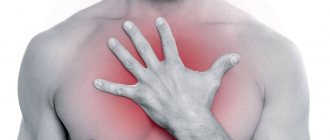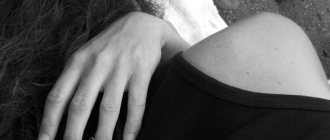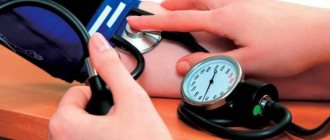When there is pain under the breasts, it causes significant discomfort and deterioration in well-being. Moreover, if the pathology is not diagnosed on time, this can lead to the development of serious diseases that pose a threat not only to health, but also to life. To understand the seriousness of the problem of pain in this localization, you need to know what important organs are located in this area.
What hurts under my left breast?
The heart is located under the left breast, so heart pathologies are often considered the cause of pain. Manifestations of discomfort in such localization indicate serious problems. Pain irradiates to the left shoulder blade. Such signs require urgent professional help and medical examination.
In addition, some organs of the gastrointestinal tract are located on the left side. Pain in this area may be associated with gastritis or stomach ulcers, as well as pancreatic disease. With gastrointestinal pathologies, not only does there pain under the left breast, but additional symptoms such as heartburn and belching, nausea and vomiting are observed.
Pain under the left breast due to intercostal neuralgia. In this case, discomfort is always scary, as it can take you by surprise. This pathology can be triggered by hypothermia, stress, or even an uncomfortable posture during a night's rest.
Stitching pain
Elderly people often complain of a stabbing sensation in the left side of the chest and immediately diagnose themselves with cardiac problems. But few people know that the heart is located in the center of the chest cavity rather than on the left side. This type of pain indicates disturbances in the functioning of the spine and central nervous system.
A stabbing pain in the left side of the chest is most likely caused by muscle spasms and is not associated with heart disease. But stabbing pain can easily be confused with cutting pain, which appears with injuries to the abdominal cavity and petrification of the stomach walls.
Stitching pains are constant and appear with sudden movements or severe coughing.
What hurts under my right breast?
To understand why it hurts under the right breast, you need to know what organs are there.
In this place are located:
- Liver.
- Gallbladder.
- Part of the intestine.
- Part of the diaphragm.
Unpleasant signs that disrupt a normal lifestyle are often associated with the development of gastrointestinal pathologies. For example, gastroesophageal reflux or a stomach ulcer can provoke discomfort. Pain of this localization is also characteristic of cholecystitis.
Pain also irradiates into this area when:
- diseases of the respiratory system, such as pleurisy, bronchitis or pneumonia;
- heart problems - angina pectoris or myocardial infarction;
- diseases of the circulatory system, in particular acute leukemia;
- injuries to the spine, chest or abdominal organs;
- psychosomatic disorders.
Preventive measures
Quitting cigarettes reduces the risk of respiratory pathologies
There is no specific prevention of unpleasant sensations. But following the rules of a healthy lifestyle greatly reduces the risk of pathologies:
- Gastrointestinal tract, liver, gall bladder - with proper nutrition, absence of spicy foods and alcohol in the diet;
- respiratory organs – when quitting cigarettes;
- cardiovascular system - during physical activity.
If you avoid unfavorable loads and minimize the risk of injury, you don’t have to worry about the performance of the spine and the integrity of the chest.
Pain in and under the right breast rarely indicates a serious health problem and is usually the result of muscle strains, minor injuries, or hormonal changes.
However, a symptom can indicate the development of dangerous diseases, for example, infections, inflammation in the chest, and even oncology. And not only among the fair sex, but also among men. This is why it is so important to undergo a medical examination if suspicious symptoms appear.
Diseases accompanied by pain under the breasts
There are many diseases, the symptom of which is pain in this localization. Trying to make a diagnosis and prescribe treatment for yourself is very dangerous. This can cause a lot of harm and cause serious complications.
From the left side
A clear symptom of a heart attack is chest pain on the left side. The pain syndrome during a heart attack is especially severe. It usually originates from the middle of the sternum and moves to the left. This pain usually lasts for several minutes, then some weakening occurs, after which the attack repeats. A characteristic additional symptom is a feeling of chest compression. Severe dizziness, shortness of breath and profuse sweating are also observed. Among the psychological factors, it should be noted an acute sense of doom and fear of death.
In addition to heart attack, there are a number of other heart diseases that cause pain on the left side of the chest:
- Angina pectoris
. Discomfort in this case additionally manifests itself in the arms, jaw, neck, and back. Mistakenly, such an attack can be confused with a malfunction of the digestive process, as it is accompanied by nausea and shortness of breath. - Pericarditis
. In this case, the pericardial sac becomes inflamed. The symptom is a piercing pain radiating to the shoulders. Its intensity increases with deep breathing. Dizziness, shortness of breath and increased sweating also occur.
Pain under the breasts is also accompanied by pathologies of the gastrointestinal tract. They are provoked by gastritis, in which symptoms such as heartburn, bloating, and nausea are observed.
Another common condition is pancreatitis. Inflammation of the pancreas can begin very acutely. Additionally, there is always nausea and vomiting, which does not bring relief. Against the background of a sharp deterioration in the condition, an increase in pulse rate and fever are observed. In chronic pancreatitis, such attacks may occur periodically. They are sometimes accompanied by diarrhea.
Other diseases can also be a provoking factor:
- Left-sided pleurisy
, which is characterized by inflammation of the lining of the lung. - Enlarged or ruptured spleen
. In the first case, the condition worsens when eating and is characterized by excessive fatigue. In the second case, severe internal bleeding, which cannot be stopped without surgery, is life-threatening.
Sometimes discomfort is associated with natural physiological processes during pregnancy. As a rule, it occurs in the third trimester and is caused by an increase in the size of the uterus, which puts pressure on the internal organs.
Right under the chest
Pain is characteristic of chronic liver diseases. This is usually associated with the abuse of fatty and fried foods, as well as alcohol. If you follow a diet, your condition will stabilize faster. Typically, hepatic colic, which causes severe discomfort, is not accompanied by any additional symptoms.
Constant pain in this localization is associated with liver cancer. In this case, pain radiates to the right arm. Over time, a feeling of bitterness in the mouth may appear. The liver gradually enlarges, the skin and sclera of the eyes turn yellow. This is a very serious condition that is life-threatening.
In the side
Pain in the right side is a common sign of cholecystitis. The pathology is associated with stagnation of bile or blockage of the bile ducts. Additional symptoms are nausea and vomiting, fever. Sometimes with cholecystitis, pain irradiates into the spine and right shoulder blade.
With pyelonephritis, discomfort occurs in the right hypochondrium. In this case, the inflammatory process in the kidneys always occurs acutely against the background of an increase in temperature. Additionally, pain radiates to the back and frequent urination with severe pain is observed.
Pain in the right or left side, in the hypochondrium may be associated with intercostal neuralgia. It is characterized by pinched nerve roots. It can occur against the background of hypothermia and intense physical activity. Pulling and aching pain in the ribs can be caused by strong physical exertion, and it can also appear after injuries and bruises.
Under the arm
In most cases, irradiation of pain into the axillary area occurs with the development of heart pathologies - for example, coronary artery disease. This disease is associated with insufficient blood supply to the heart muscle.
An attack can be triggered by nervous feelings, strong emotional stress or fear. Pain can also occur in unprepared people due to increased physical activity. Additional symptoms include rapid heartbeat and shortness of breath. In dangerous situations, dizziness and general weakness occur, and vomiting may occur.
Another common disease that radiates to the axillary area is myocarditis. It is characterized by inflammation of the heart muscle caused by infectious-allergic factors or rheumatism. In addition to discomfort in the armpit area, numbness of the arm may occur. In severe attacks, breathing becomes very difficult, and severe weakness is observed.
In women, discomfort under the armpit can be caused by mastopathy. As a rule, in this case the pain syndrome is of a pulling, aching nature. Osteochondrosis, which is characterized by pinching of nerve roots in the spinal region due to disturbances in cartilage tissue, can provoke discomfort in this localization.
When you feel a dull ache
This type of pain under the breast on the left is observed in various diseases. The most dangerous of them is breast cancer. When an oncological disease begins to hurt in the second stage, women should not hesitate to visit a mammologist.
Men may suffer from pain in the left chest when there are diseases of the testicles and adrenal glands with hormonal imbalance.
Dull pain syndrome can be a symptom of false angina with spasm of blood vessels that do not have physiological disorders. A similar manifestation of dull pain is observed with cardialgia of vegetative crisis. The reason is emotional (death of loved ones, stress at work, etc.), hormonal (pregnancy, menopause, etc.), physical and chemical (excessive physical activity, binge drinking, etc.) overload.
Mild pain syndrome may be present in chronic diseases of the gastrointestinal tract.
Myocardial infarction with necrosis of a portion of the heart muscle
Physiological pain under the breasts in women
Pain in women under the breasts occurs due to certain physiological processes. First of all, they are observed in the third trimester of pregnancy. This is explained very simply. By this time, the uterus has significantly increased in size, therefore putting strong pressure on the internal organs. This factor causes pain of varying intensity. But, as a rule, when changing body position, the pain quickly subsides. In addition, sudden pain appears due to active movements of the fetus when it turns over.
Most women experience cyclical pain in the breasts and under the breasts every month. They are associated with the menstrual cycle. This physiological phenomenon is called “mastalgia”. Pain appears immediately after ovulation and normally lasts for several days. In most cases, they are of moderate intensity and are accompanied by a feeling of breast swelling.
When breastfeeding, discomfort should normally be absent. But in reality this is not always the case. Most often, pain occurs when the baby is not properly attached to the breast. During feeding, you need to monitor the baby’s position and adjust the breast latch if necessary.
Attention!
Often, when there is pain under the breasts during feeding, mastitis can be suspected. This is a dangerous pathology that requires urgent measures to be taken for treatment.
Additional reasons
Pain on the right side can also be caused by the following reasons:
- Pneumonia. It may also hurt on the right side near the chest due to infectious diseases of the upper respiratory tract. Lung pathology is often accompanied by similar sensations with unilateral inflammation. Additional signs may include general poor health, cough, and fever.
- Acute tracheitis and bronchitis. Inflammation resulting from infection in the respiratory organs is often characterized by pain on the right or left side of the chest. The symptoms are accompanied by a hysterical cough, shortness of breath and pressing sensations in the sternum. The temperature often rises.
- Osteocondritis of the spine. With degenerative processes occurring in the cartilage tissue, which is located between the vertebrae, the right side under the breast often hurts. In this case, discomfort is accompanied by pain in a certain part of the spine, depending on the area of localization of the pathological focus.
- Intercostal neuralgia. It occurs most often and can go away without appropriate treatment. In this case, the discomfort is colic in nature and can intensify when changing position.
- ARVI and influenza. In acute viral respiratory diseases, a similar symptom may occur. It is often accompanied by fever, pain in the head and throat, and aching muscles and joints.
- Staying in one position for a long time. For people who lead a sedentary lifestyle, this symptom is not uncommon. Often this illness is characteristic of office workers who are accustomed to being in a sitting position for a long time.
What to do if there is pain under the breasts
When there is pain under the breasts, it can be associated with a wide variety of pathologies, so it is strictly forbidden to self-medicate. If you suspect a heart attack, you should urgently call an ambulance. Under no circumstances should you put it off and try to relieve the pain on your own. Any delay could result in death. You should try to remain calm and not give in to panic.
The main methods of instrumental research that are used to diagnose pathologies accompanied by pain under the breast:
- radiography
. With its help, you can determine pathological changes in the lungs and other organs; - Ultrasound
. Such a study makes it possible to make an accurate diagnosis for mastopathy, cholecystitis and liver pathologies; - electrocardiogram
. It can be used to confirm or refute the presence of heart pathologies.
An experienced doctor always conducts not only an external examination, but also performs palpation, which allows one to identify changes in the size of certain internal organs. You will also need specialized studies of the spine, which can detect osteochondrosis and hernias. These diseases are a common cause of pain in the right side. If pain of an unknown nature occurs, you should first visit a therapist’s office, who will prescribe basic tests. Based on their results, the patient will be referred to doctors of a narrow specialty - a surgeon, neurologist, gastroenterologist, mammologist.
Diagnosis and treatment
To establish the exact cause, a specialist needs to conduct a survey and an initial examination. And then, depending on the complaints, the following may be prescribed:
- Laboratory research.
- ECG.
- Fluorography.
- MRI or CT.
- Ultrasound of the heart, kidneys, liver and pancreas.
- FGS for suspected ulcers or gastritis.
It is important to know that diagnosis may take a long time, since this symptom is characteristic of many diseases. First, doctors try to rule out serious acute conditions, and only then begin a comprehensive examination.
Neuralgia
Another ailment that cannot be ignored. Intercostal neuralgia on the right is a common cause of sharp and severe chest pain. In addition to this symptom, muscle spasms, a burning sensation and even short-term numbness may also occur.
What are the reasons? There are many of them - injuries to the spine and ribs, diabetes, gastrointestinal diseases, deficiency of micro- and macroelements, vitamin deficiency, inflammation of the spinal muscles, the presence of tumors, as well as osteochondrosis and alcohol addiction. In women, neuralgia sometimes appears due to wearing an excessively small, constricting bra for a long time.
Diagnosis involves electroneurography, MRI and CT, as well as checking the integrity of bone tissue using X-rays. Then, based on the results obtained, the doctor prescribes the most appropriate medications that can effectively eliminate the inflammation and pain that accompany a pinched nerve.
Be that as it may, the patient will have to observe bed rest (sleep on a hard and level bed), make dry compresses, use natural sedatives and attend light warming massage sessions.
Types of pain and possible diagnoses
Carrying out an examination, the specialist clarifies an important nuance for himself - what kind of pain the patient has, how he can describe it. The information obtained simplifies further diagnosis, since every competent doctor knows that different types of pain indicate the presence of certain diseases:
- Dull pain is a sign of injury (chest contusion, muscle strain), osteochondrosis of the thoracic spine, cracked ribs
- Pulling is a symptom of intercostal neuralgia, appears after physical exertion, a long stay in a stationary position, hypothermia
- Contracting - spasms indicate the presence of stomach pathology, impaired blood circulation after physical activity, osteochondrosis. Patients also sometimes perceive arrhythmia as a tugging, unpleasant sensation.
Despite the differences in the listed types of pain, they are united by the need to visit a specialist, conduct an examination, and possibly even undergo treatment.
It's a dull pain
The symptom of vague pain is characteristic of the course of gastric ulcer, inflammation of the intestinal mucosa. Additional symptoms are lack of appetite, nausea, bloating, diarrhea mixed with particles of undigested food. Discomfort in the abdomen appears in the morning, after eating. Aching pain under the breast is one of the signs of myocarditis. Especially if the appearance of an unpleasant sensation was preceded by physical activity.
Strong pain
Increased pain indicates the development of many pathologies, but most often they are:
- myocardial infarction
- arterial spasm
- emergency stomach or intestinal conditions
- aortic aneurysm
- pneumothorax
- pancreatitis
- metastases to the lungs directed by a malignant tumor present in the body
In this case, attention is drawn to a sharp decrease in blood pressure, pale skin, sweat on the face, and weakness. With a gastric ulcer, blood appears in the stool and vomit. With pancreatitis, attention is drawn to the girdling nature of the pain. If the deterioration of the condition is caused by intestinal obstruction, there is no bowel movement for several days, intoxication is present, and the complexion becomes sallow.
Metastases in the lungs are detected during radiation imaging methods. As in the pelvic bones, the brain, they can be directed to the respiratory organs by malignant tumor processes present in the body.
Sharp pain
Problems with the condition of the gallbladder can cause sharp pain; against the background of renal colic, patients also often experience an unpleasant sensation under the breast. This type of pain syndrome is characteristic of thromboembolism, an extremely dangerous pathological condition. In this case, characteristic signs are instant blueness of the skin of the face, the appearance of bleeding through the oral cavity, and loss of consciousness. This condition is known to be fatal and is therefore better prevented than treated.
Stitching pain
Pain under the breast with episodes of tingling in the right side is a sign of impaired functional activity of the liver. The development of the condition is promoted by overeating, consumption of fatty foods, bending of the gallbladder, cirrhosis, and cholelithiasis. If it is determined that the liver is in order, the cause should be sought in the condition of the diaphragm. But most often, signs of tingling are associated with digestive problems, constipation and inflammation developing against their background. Often, stabbing sensations are accompanied by muscle inflammation (after hypothermia, stretching, excessive physical activity).
Pain under the shoulder blade
If the pain is not associated with a heart disorder, the sign indicates the presence of problems with the diaphragm and spine. When a hernia forms in the diaphragm, intense discomfort appears due to the upward displacement of the stomach. The diaphragm anatomically separates the thoracic cavity from the abdominal cavity. The pressure inside causes discomfort.
Pathologies of the spine manifest themselves as follows:
- the patient is bothered by a nagging or burning pain
- Changing position does not bring long-term relief
- the problem area of the body may be deformed - due to swelling or disintegration of the cartilage tissue of the vertebrae
- physical activity is limited
The listed violations are clearly displayed in the image taken during an x-ray examination.
Chest pain in women
Soreness of the mammary glands is a tissue reaction to hormonal changes. Normally, swelling and increased sensitivity of the female breast accompanies the period on the eve of menstruation, pregnancy, and the postpartum state. But in other cases, pain in the mammary glands indicates the presence of a disease. Its nature (benign or malignant) is determined by mammography. Alarming signs are breast deformation, changes in the color and structure of the nipple and areola.

